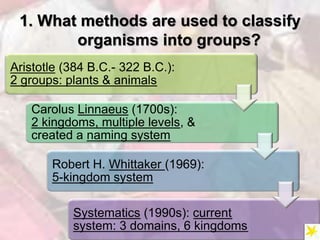Ch. 1.2 Classification
- 1. 2/11/15 Bell work: What are the 6 kingdoms of life? (refer to Ch. 1.2 WS or book, if needed) Announcements: âĒ Ch. 6 Retakes available on Blackboard #18 Objectives: Students will classify objects based on shared characteristics.
- 3. Focus Questions 1. What methods are used to classify organisms into groups? 2. What is binomial nomenclature? 3. What tools can we use to classify organisms?
- 4. 1. What methods are used to classify organisms into groups? Aristotle (384 B.C.- 322 B.C.): 2 groups: plants & animals Carolus Linnaeus (1700s): 2 kingdoms, multiple levels, & created a naming system Robert H. Whittaker (1969): 5-kingdom system Systematics (1990s): current system: 3 domains, 6 kingdoms
- 5. âĒ The classification system of living things is still changing. âĒ Systematics uses all known evidence about organisms, such as: â Cell type, its habitat, the way an organism obtains food & energy, structure & function of its features, common ancestry, and DNA structure 1. What methods are used to classify organisms into groups?
- 8. 8 levels of classification: D K P C O F G S 1. What methods are used to classify organisms into groups? 8 levels of classification: Domain Kingdom Phylum Class Order Family Genus Species 8 levels of classification: Daring King Phillip Came Over For Great Spaghetti
- 10. What level of classification comes after phylum? A. Kingdom B. Class C. Order D. Genus Kingdom Class Order Genus 0 000 45
- 11. Who was one of the first people to classify organisms? a. Linnaeus b. Whittaker c. Darwin d. Aristotle Linnaeus W hittaker Darw in Aristotle 0 000 45
- 12. âĒ Linnaeusâs naming system that gives each organism a 2-word scientific name (species). âĒ A species is a group of organisms with similar traits & with the ability to produce fertile offspring. âĒ Example: common house cat Ex: Felis domesticus 1st part = Genus name 2nd part = specific name 2. What is binomial nomenclature?
- 13. What does the first part of a scientific name refer to? a. Genus b. Species c. Specific name d. Family Genus Species Specificnam e Fam ily 0 000 45
- 14. âĒ Dichotomous key: â A series of paired statements âĒ Cladograms: â Branched diagram that shows relationships among organisms (common ancestry) 3. What tools can we use to classify organisms?
- 15. 3. What tools can we use to classify organisms?
- 16. Enter question text...Which animal is more closely related to the chimp? a. Lizard b. Salamander c. Mouse d. Pigeon Lizard Salam ander M ouse Pigeon 0 000 45
- 17. What is the key difference (characteristic) between the salamander and the lizard? a. Jaws b. Lungs c. Claws or nails d. Feathers e. Fur, mammary glands Jaw s LungsClaw sornails Feathers Fur,m am m aryglands 0 0 000 45
- 18. Which is more closely related to the Perch? a. Salamander b. Lizard c. Pigeon d. Mouse e. Chimp Salam ander Lizard Pigeon M ouse Chim p 0 0 000 45
- 19. Physical similarities are the only characteristics used to classify organisms. a. Agree b. Disagree Agree Disagree 00 30
- 20. A dichotomous key can be used to identify unknown organisms. a. Agree b. Disagree Agree Disagree 00 30



















